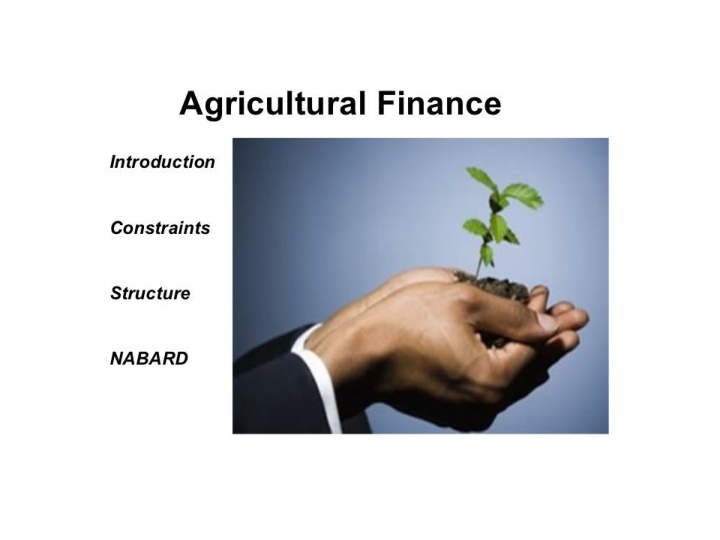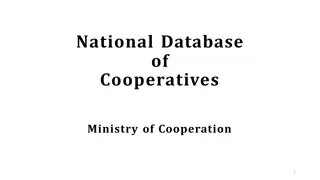
Understanding Agricultural Finance and Cooperatives for Sustainable Growth
Explore the world of agricultural finance and cooperatives, delving into the significance of financial support for farm business development. Learn about the evolution of credit systems, sources of finance, and ways to improve rural credit structures for a thriving agricultural sector. Discover the crucial role of agricultural finance in boosting productivity, enhancing resource management, and elevating the standard of living in rural communities.
Download Presentation

Please find below an Image/Link to download the presentation.
The content on the website is provided AS IS for your information and personal use only. It may not be sold, licensed, or shared on other websites without obtaining consent from the author. If you encounter any issues during the download, it is possible that the publisher has removed the file from their server.
You are allowed to download the files provided on this website for personal or commercial use, subject to the condition that they are used lawfully. All files are the property of their respective owners.
The content on the website is provided AS IS for your information and personal use only. It may not be sold, licensed, or shared on other websites without obtaining consent from the author.
E N D
Presentation Transcript
Agricultural Finance and Cooperatives Introduction
Session : one Introduction Meaning of Agricultural finance Classification of Finance Sources of Agricultural Finance Agency wise credit flow to Agriculture in India Weaknesses in Rural credit structure Suggestions for improving Rural credit system
Introduction: Professional moneylenders were the only source of credit to agriculture till 1935 They use to charge unduly high rates of interest and follow serious practices while giving loans and recovering from borrowers As a result, farmers were heavily burdened with debts and many of them perpetuated debts With the passing of Reserve Bank of India Act 1934, District Central Co-op. Development Banks Act, leading to improvements in agricultural credit Banks Act and Land
Agricultural examining pertaining to farm business, which is the core sector of India. The financial aspects include money matters relating to production of agricultural disposal. finance and generally means financial studying, aspects analyzing the products and their
Agricultural finance is the study of financing and liquidity services credit provides to farm borrowers. It is also considered as the study of those financial intermediaries who provide loan funds to agriculture and the financial markets intermediaries obtain their loan able funds in which these
Significance of Agricultural Finance: Agri- finance assumes vital and significant importance in the agro socio economic development of the country both at macro and micro level. It is playing a catalytic role in strengthening the farm business and augmenting the productivity of scarce resources. When newly developed potential seeds are combined with purchased inputs like fertilizers & plant protection chemicals in appropriate / requisite proportions will result in higher productivity. 3) Use of new technological inputs purchased through farm finance helps to increase the agricultural productivity.
Accretion infrastructure provided by large scale financial investment activities results in increased farm income levels leading to increased standard of living of rural masses. Farm finance can also reduce the regional economic imbalances and is equally good at reducing the inter farm asset and wealth variations. Farm finance is like a lever with both forward and backward linkages to the economic development at micro and macro level. As Indian agriculture is still traditional and subsistence in nature, agricultural finance is needed to create the supporting infrastructure for adoption of new technology to in farm assets and farm supporting
Classification of Finance : Time Purpose Security Lenders Borrowers
Scope: Agricultural finance deals Macro finance : deals with different sources of raising funds, lending procedures, rules, regulations, monitoring & controlling procedures of different argil. institutions towards funding for agriculture & allied activities. Micro finance : deals with the financial management of the individual farm business
Importance The agro-socio-economic development of the country both at micro / individual level & at macro / aggregate level Higher productivity of resources Increased farm income level Reduction in regional economic imbalances Strengthening and development of both input & output market
Role ofAgriculture in Indian Economy INTRODUCTION Agriculture is the backbone of Indian economy. Agriculture is the most important occupation for most of the Indian families. In India, agriculture contributes about 16% of total GDP & 10% of total exports. About 75% people are living in rural areas and are still dependent onAgriculture.
Agriculture is the most important sector of Indian Economy. Indian agriculture sector accounts for 18 per cent of India's gross domestic product (GDP) and provides employment to 50% of the countries workforce. India is the world's largest producer of pulses, rice, wheat, spices and spice products
Indian agriculture is plagued by several problems; some of them are natural and some others are manmade. Small and fragmented land-holdings Seeds: ... Manures, Fertilizers and Biocides Irrigation Lack of mechanization Soil erosion Agricultural Marketing Inadequate storage facilities
Importance of Agriculture in Indian Economy Agricultural influence on national income Agriculture plays vital role in generating employment Agriculture makes provision for food for the ever increasing population Contribution to capital formation Supply of raw material to agro-based industries Market for industrial products Influence on internal and external trade and commerce Contribution in government budget






















